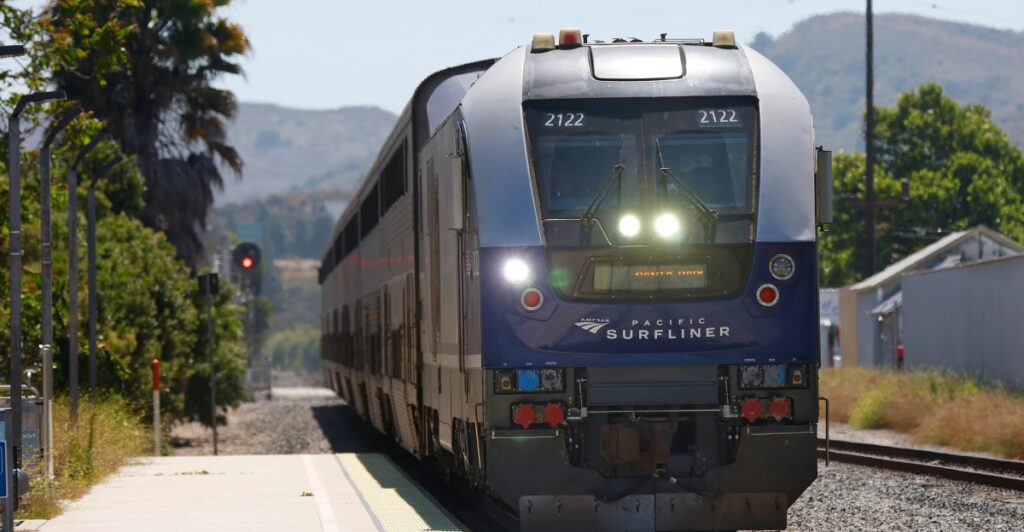If you’re traveling in America, there are plenty of ways to get to where you want to go. Interstate highways make road trips possible. Planes let you go from one side of the country to the other in a matter of hours. But there’s one mode of transportation that still eludes the US: high-speed rail. Countries in Europe and Asia have safe high-speed trains that can take you from city to city as fast as 200 miles per hour, while a little more than half of Amtrak trains reach speeds up to 100 miles per hour. So what is the state of high-speed rail in the US?
“Nonexistent and terrible,” says Michael Kimmelman, editor-at-large of the New York Times’s Headway, a section that focuses on progress when it comes to the world’s biggest challenges. “The United States has consistently failed to build high-speed rail, and there’s been conversation about it for a long time.” Despite the setbacks, it still could be on the horizon. “There’s some glimmer of hope. High-speed rail exists all around the world.”
What’s the deal with the lack of high-speed rail in the US? Why hasn’t the country caught up? And will we ever have high-speed trains? That was the question we explored in this week’s episode of Explain It to Me, Vox’s weekly call-in podcast.
Below is an excerpt of our conversation with Kimmelman, edited for length and clarity. You can listen to the full episode on Apple Podcasts, Spotify, or wherever you get podcasts. If you’d like to submit a question, send an email to askvox@vox.com or call 1-800-618-8545.
How’d we end up falling behind in passenger rail?
The story is usually told that we once had a great rail system. The country was connected by the transcontinental railway in the 19th century. And we gave up that advantage. Once the automobile became something that people could afford, and it wasn’t just for rich people, people wanted roads, so we invested less and less in trains.
We have a million obstacles to progress and very few easy paths.
That’s part of the story, but there are a lot of other reasons why we failed too, which is that we’ve become a country that’s extremely regulated and that has made it very difficult to build anything big anymore. We have a million obstacles to progress and very few easy paths.
Who is getting high-speed rail right?
China has built nearly 30,000 miles of high-speed rail just in the past couple of decades. Japan, of course, has a famous high-speed bullet train called the Shinkansen and has had that for decades. And most of western Europe is connected by high-speed rail. It’s perfectly normal in Europe to go to your local train station and get on a train that will take you 200 miles an hour to another city.
We were supposed to have high-speed rail in the US. What happened to that project out in California that was supposed to connect Los Angeles to San Francisco?
Back in the 1980s, Gov. Jerry Brown had this idea that California could use high-speed rail. By the 1990s, California had a plan in place. It took them until 2008 to approve a measure that set aside about $10 billion to construct a high-speed rail, which was going to connect LA and San Francisco. It would take about two hours and 40 minutes to get directly from one city to the other, the cost estimate was around $33 billion, and the completion date was 2020. But by 2018, it was clear this was never going to happen.
The cost estimates more than doubled, and they would ultimately triple. When Gavin Newsom, the current governor, succeeded Brown, he spoke about the fact that this was obviously not going to be possible anytime soon. And his big promise was that possibly California might have high-speed rail between Bakersfield and Merced, two cities in the Central Valley that no one had really asked for high-speed rail to travel between. Now, that’s pretty unlikely too. The estimated completion date would be sometime in the 2030s perhaps, and at a cost of well over $110 billion.
That’s California. Is there high-speed rail in other parts of the country?
Florida’s a good example. Brightline is a privately owned and operated rail line that runs between Miami and Orlando, on what used to be freight line tracks. In short, they didn’t have to go through a million of these approval processes to get it done because they kind of already owned the route.
California to Vegas is the plan for Brightline 2. It’s not just that you have a private investor as opposed to a government; it’s also that you have a given route which presents itself that makes economic sense and makes sense for consumers. As a consequence, that may actually happen. And that might be in fact the first genuine high-speed rail in the United States.
The safety record of Brightline in Florida is really troubling. Partly it’s growing pains transitioning from a freight rail to a passenger train that runs through the middle of cities, but the company bears a lot of the blame. It’s clearly a crisis and a learning curve for the company and those Florida communities.
How hopeful are you about the future of high-speed rail in the US?
I think it is a possibility. The fact that we’re having conversations around our inability to get big things done is actually not the same as the conversations we were having five or 10 years ago. You see some signs of that change in California; for instance, the repeal of some of the environmental regulations that have been weaponized to prevent things like high-speed rail, and other things which actually are environmentally good.
I’m not entirely pessimistic about this. High-speed rail is something that could connect large cities. And those cities could really use it, and that will serve many, many millions of Americans.

